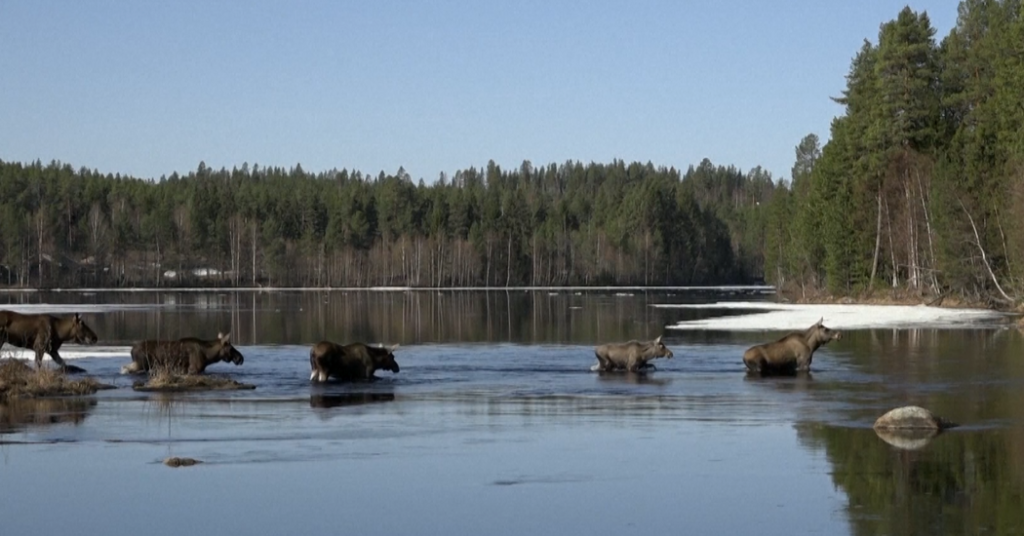Who would spend hours a day watching moose trudge through northern Sweden on their annual spring migration? Lots of people, it turns out.
In fact, “The Great Moose Migration,” an annual Swedish livestream that began on Tuesday, may soon dethrone the opening credits of “Monty Python and the Holy Grail” as humanity’s greatest artistic tribute to the Swedish moose.
Perhaps the power transfer is already over.
“I didn’t really think it would hit,” said Arne Nilsson, 54, speaking of when it started in 2019. “I thought it would be ridiculous,” he added.
Mr. Nilsson, who grew up in the Swedish woods, was wrong. Now, he will devote six hours a day to moderating a Facebook group of over 77,000 fans, many of whom will spend the next three weeks watching moose on SVT, Sweden’s national broadcaster. (The group’s name is self-explanatory: “Vi som gillar den stora algvandringen pa SVT!” or “We who like the great moose migration on SVT!”)
Unlike many other nature programs, which may have music and narration, the moose march broadcast is raw. It is also live. The only “edits” are cuts between the 34 cameras along the migration path.
That’s the draw, Mr. Nilsson said: The moose do not know they are being watched. They certainly do not know they are being watched by zealots live-blogging their minute-by-minute joy of watching the migration.
“This isn’t staged,” he said. “This isn’t cut together. This is reality TV at its finest.”
About 300,000 moose (yes, that’s the plural of moose) live in Sweden, said Goran Ericsson, who leads the moose research group at the Swedish University of Agricultural Sciences. The 100 or so that may appear on the livestream are traveling on a path their ancestors have followed since the ice age.
Last year, millions of people watched the livestream, said Johan Erhag, the executive producer. And the fans are downright obsessed.
“Some people are fanatics,” said Lasse Nasstrom, 59, a member of the Facebook group, who streams it on one of his three monitors while he works on the others. “I don’t believe some of them sleep during those weeks.”
Some people, like Lillemor Elfgren, start their days by checking for updates. Ms. Elfgren, 43, lives in Vannasby, in northeast Sweden, and gets a notification whenever there’s any real action.
“Has anything interesting happened?” she said. “Is someone about to swim?”
This is hardly the only animal livestream to delight humans. There’s “Planet Earth,” of course, and the Dutch “fish doorbell,” where fans help the fish migration. Some friends count down the final seconds at the end of the year to the clock on a watering hole in the Namibian desert.
(There’s even a cheese cam, for people who want to watch wheels of Cheddar age in real time.)
In Sweden, even when no moose are visible (which happens more often than one might expect from a moose livestream), the woods stun and awe. Rivers flow against snowy banks. Light scythes through sun-dappled groves. Swans glide, white and wild. These are like Tarkovsky vistas, set to the sound of birds and wind.
“I want it to be like a living painting on the wall,” Stefan Edlund, the program’s producer, said while sitting next to Dr. Ericsson as a wall of moose feeds blinked on screens behind them.
Mr. Edlund was inspired by similar “slow television” streams from Norway, a center of the tranquil Nordic style. He said he ignored advice to include flashy graphics or use a human presenter. The purity of the woods was the point.
Their cameras will film the moose, undisturbed, until May 4, when the feed is scheduled to end. That is, of course, if they can locate moose to film.
“It’s a bit of a sport to find them,” he said.
So he and his team make it into a game, at least at the command center. They scour the feeds, turning the screens into a “Where’s Waldo” of the Cervidae family. Could that be one? Or that?
They’re keeping a tally on a yellow paper, with a moose-to-stone spotting ratio. As of noon on Tuesday, stones were in the lead.
“They are also called ‘near-moose experiences,’” quipped Dr. Ericsson, the moose expert.
“It’s a bit of fun,” Mr. Edlund added, shrugging as he looked at the screens. “Keeps you awake.”
For fans, the feed is both an oasis and a mirage. They sit gazing at Sweden’s forests and rivers, posting their delight online in unison.
Marianne Hauger, 49, turns it on while at home on Trundon, a small island in northeast Sweden.
She loves moose, of course. But the conversation is the real draw. “When you’re in this chat you forget that there are bad things in the world,” she said.
And, she said, there’s always a letdown when it ends each year. “It felt so empty,” she said, adding, “Thankfully, it’s in the middle of May so you have summer to look forward to.”











More Stories
19 Big Cats Rescued in Spain as Police Raid Animal Smuggling Ring
The First Ever Sighting of a Colossal Squid
Autopsies of Slain Gaza Medics Show Some Were Shot in the Head